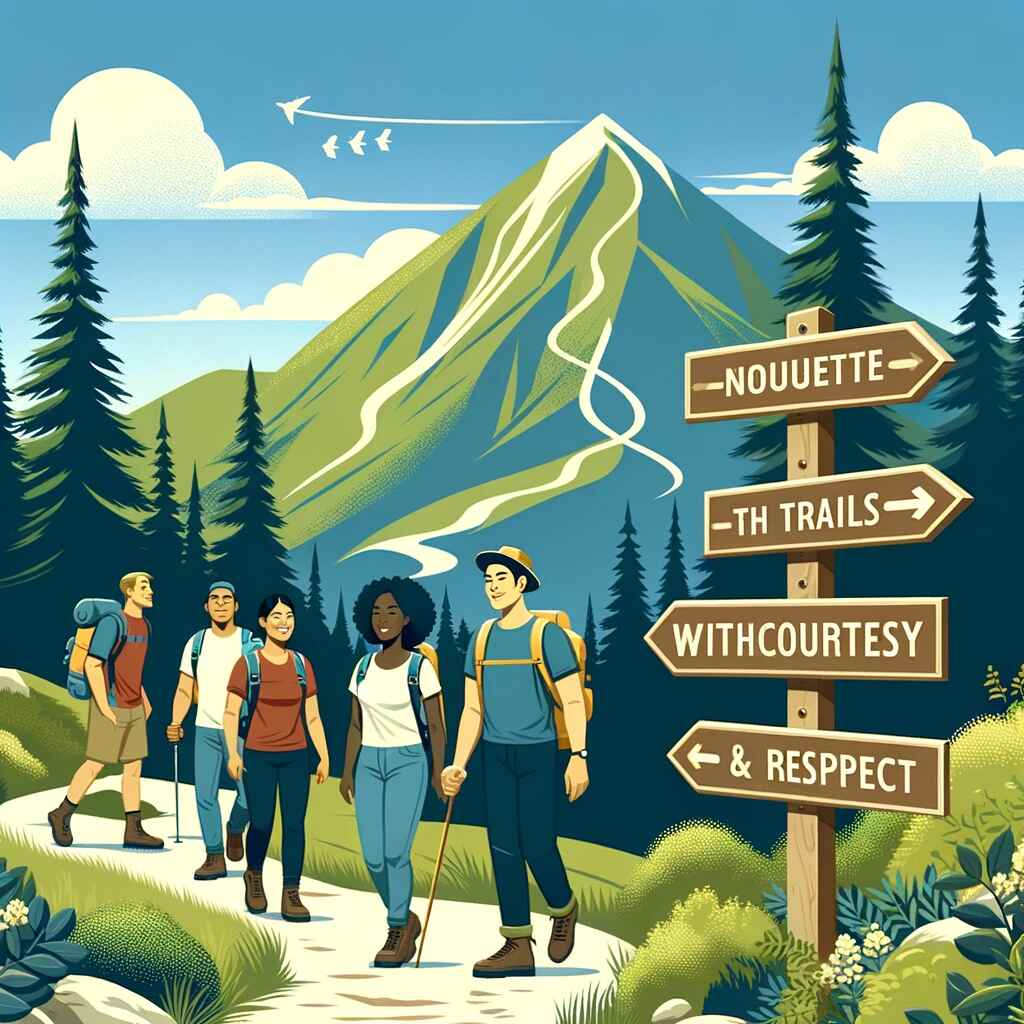Hiking is a wonderful way to connect with nature, stay active, and enjoy the great outdoors. Whether you’re a seasoned hiker or just starting out, it’s essential to understand and practice hiking etiquette. Proper hiking etiquette ensures that everyone on the trail has a safe and enjoyable experience.
In this comprehensive guide, we will explore various aspects of hiking etiquette, including bathroom etiquette, passing other hikers, right of way, yielding, and general dos and don’ts. Let’s embark on this journey to become responsible and courteous hikers.
Table of Contents:
- Hiking Etiquette Do’s and Don’ts
- Hiking Bathroom Etiquette
- Passing Other Hikers with Grace
- Hiking Etiquette: The Right of Way
- Yielding on the Trail
- Hiking Rules and Trail Etiquette
- Trail Hiking Etiquette for Responsible Explorers
- The Art of Proper Hiking Etiquette
Hiking Etiquette Do’s and Don’ts
Before hitting the trail, it’s crucial to familiarize yourself with some fundamental hiking etiquette do’s and don’ts:
Do’s:
- Be prepared: Plan ahead, research the trail, check the weather, and pack appropriately. Adequate preparation ensures a safer and more enjoyable hike.
- Leave no trace: Respect the environment by packing out all your trash and disposing of waste properly.
- Stay on the trail: Stick to designated paths to avoid damaging fragile ecosystems and wildlife habitats.
- Share the trail: Be courteous to other hikers, bikers, or horseback riders. Yield when necessary, and maintain a friendly attitude.
- Stay quiet: Minimize noise pollution to allow others to enjoy the tranquility of nature.
- Respect wildlife: Observe animals from a distance, avoid feeding them, and refrain from disrupting their natural behavior.
- Practice fire safety: Follow local regulations concerning fires and camp stoves, and always fully extinguish fires before leaving.
Don’ts:
- Litter: Never leave trash or discarded items behind. This includes food scraps, cigarette butts, and even biodegradable materials.
- Vandalism: Do not deface or damage natural features, such as rocks, trees, or signs.
- Disturb others: Keep your music and conversations at a respectful volume. Some hikers seek solitude and serenity.
- Wander off-trail: Straying from designated paths can harm sensitive ecosystems and can be dangerous.
- Feeding wildlife: Feeding animals can disrupt their natural diets and behavior, leading to long-term harm.
- Irresponsible fire use: Failing to properly manage fires can lead to wildfires and endanger lives.
Hiking Bathroom Etiquette
When nature calls on the trail, it’s essential to know how to answer it without harming the environment or causing discomfort to fellow hikers.
Bathroom etiquette in the outdoors includes:
- Use established facilities: Whenever possible, use designated bathrooms or outhouses provided at trailheads or campsites.
- Pack out your waste: In areas without restroom facilities, follow a “leave no trace” approach. Use a portable toilet or dig a “cathole” at least 6-8 inches deep, located at least 200 feet away from water sources and trails. Pack out used toilet paper in a sealed bag.
- Feminine hygiene products: Pack out used hygiene products in a sealed bag. Do not bury them, as they may not decompose quickly.
- Wash your hands: Use hand sanitizer or biodegradable soap to clean your hands after using the restroom, even if you’re far from running water.
- Practice discretion: Find a secluded spot away from the trail and other hikers for privacy.
Passing Other Hikers with Grace
One common scenario on the trail is the need to pass other hikers, whether they’re moving slower or coming in the opposite direction. Passing etiquette is essential to maintain a respectful and safe hiking environment.
Tips for passing other hikers:
- Announce your presence: Before passing, let the hikers ahead know you’re approaching by saying something like “Hello” or “Excuse me.”
- Choose the right moment: Find a safe and wide section of the trail to pass. Avoid passing on narrow or steep sections.
- Stay on the trail: Do not create new paths to bypass others, as this can lead to trail erosion and environmental damage.
- Pass on the left: Just like driving, it’s customary to pass on the left side of the trail.
- Be patient: Some hikers may need a moment to step aside or find a safe spot to let you pass. Wait courteously.
- Thank them: Once you’ve successfully passed, offer a friendly “Thank you” to show your appreciation.
Hiking Etiquette: The Right of Way
Understanding the right of way on the trail is crucial to avoid conflicts and ensure a smooth hiking experience. The following guidelines can help you navigate these situations:
General right of way rules:
- Uphill hikers: Hikers moving uphill generally have the right of way. It’s easier for those moving downhill to step aside and restart their hike.
- Hikers vs. bikers: Hikers typically have the right of way over mountain bikers because they are less maneuverable. However, it’s a good practice for hikers to step aside when they see a biker to avoid abrupt stops.
- Hikers vs. equestrians: Hikers should yield to horseback riders since horses can be easily spooked. Move to the downhill side of the trail and speak calmly to the rider.
- Groups vs. solo hikers: Smaller groups or solo hikers should yield to larger groups to minimize trail congestion.
- Passing: When passing another hiker, be respectful and follow the passing etiquette mentioned earlier.
Yielding on the Trail
Yielding on the trail goes hand in hand with understanding the right of way. Here are some specific situations where yielding is crucial:
Yielding scenarios:
- Yielding to wildlife: If you encounter wildlife on the trail, always yield by maintaining a safe distance and not disturbing their natural behavior. Never approach or chase wildlife.
- Yielding to emergency personnel: If emergency personnel are on the trail, yield the right of way immediately. They may be responding to an incident that requires urgent attention.
- Yielding to trail maintenance crews: If you encounter trail maintenance crews working on the trail, yield the right of way and follow their instructions to ensure safety for both hikers and workers.
- Yielding to slower hikers: If you are a faster hiker approaching slower hikers from behind, politely announce your presence and ask if they would like you to pass. Be patient and respectful if they choose to continue at their pace.
- Yielding to horses: If you encounter equestrians on the trail, always yield to them by moving to the downhill side of the trail and speaking calmly to the rider. Give horses plenty of space to pass safely.
Yielding is all about being aware of your surroundings and showing consideration for others and the environment.
Hiking Rules and Trail Etiquette
Beyond the specific scenarios mentioned earlier, there are some general rules and trail etiquette guidelines that all hikers should follow:
- Stay on the trail: Avoid creating new paths or shortcuts, as this can lead to soil erosion and harm to the ecosystem.
- Leave no trace: Carry out all trash, including food wrappers, and dispose of it properly. Use designated trash bins when available.
- Respect trail closures: If a trail is closed due to maintenance, environmental restoration, or safety concerns, do not attempt to hike it.
- Keep pets on a leash: If you bring your dog on the trail, make sure to keep it on a leash and clean up after it.
- Campfire regulations: Follow local fire regulations, and use established fire rings or camp stoves when allowed. Always extinguish fires completely.
- Be mindful of noise: Keep noise levels to a minimum to allow others to enjoy the natural sounds of the environment.
- Share viewpoints: If you encounter a scenic viewpoint or photo opportunity, be considerate and allow others to enjoy it as well. Don’t monopolize the space for an extended period.
- Group size: Limit the size of your hiking group to minimize trail congestion and environmental impact.
Trail Hiking Etiquette for Responsible Explorers
As responsible hikers, it’s essential to go beyond the basics of trail etiquette and adopt a mindset of stewardship for our natural environments. Here are some additional considerations:
- Educate yourself: Learn about the specific rules and regulations of the trail you plan to hike. Some trails may have unique guidelines.
- Practice Leave No Trace: Commit to the Leave No Trace principles, which include minimizing your impact on the environment, wildlife, and other hikers.
- Pick up litter: Even if it’s not your trash, consider picking up litter you encounter on the trail to help maintain its beauty.
- Volunteer: Get involved in trail maintenance and restoration efforts by joining local conservation groups. This allows you to give back to the hiking community.
- Support local initiatives: Donate to organizations dedicated to preserving and protecting hiking trails and natural areas.
- Lead by example: Encourage others to follow hiking etiquette and educate newcomers on proper trail behavior.
The Art of Proper Hiking Etiquette
In conclusion, hiking etiquette is not just a set of rules; it’s a way of respecting nature, fellow hikers, and future generations of outdoor enthusiasts. By practicing proper hiking etiquette, you can enjoy a more fulfilling and harmonious hiking experience while preserving the beauty and integrity of our natural environments.
Remember to be prepared, leave no trace, yield the right of way when necessary, and always show courtesy and respect to others on the trail. By following these principles and sharing your knowledge with others, you can help create a hiking community that values and protects our outdoor treasures for generations to come.









